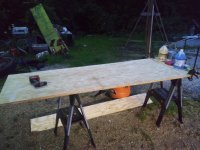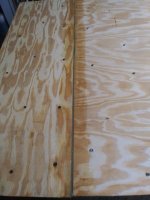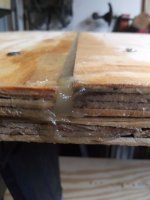TONS of great info guys! You have no idea how much I appreciate to guys teaching this young man some tricks and handing out knowledge like it's candy. So, thank you guys so much for helping me in this rebuild thus far.
I love the idea of putting two cabinet handles on the transom core. That's really smart to aid in handling it with my little girl and wife. So, I'll have at least 2 and a half people working in this with me (my wife and not so little "little girl" that's a lanky 13yr old string bean almost as tall as my wife at 5'7"!!!).
So, what schedule should I use for the outside of the transom core that faces inside the boat/forward?
My revised plan is as follows, but I'm not sure what to put on after getting the core in:
- Glue two 1/2" layers of plywood together, for 1" total thickness, with weights to bond it all. (original was a single 3/4" sheet).
- After bonding together, let sit for an hour or two if resin, or let sit for 5 days if TB3.
- Cut out transom template.
- Cut out a crescent shape of the bottom center where the drain plug is going to install. Crescent will be 4" wide and about 2" tall.
- Pre-wet the plywood core's aft facing side, and add a layer of CSM and wet out and roll.
- Let it kick off and cool.
- Pre-wet the plywood core's front facing side, and add a layer of 1708 and wet out.
- Let it kick off and cool.
- Wet out edges thoroughly to soak up resin, and add small strips of CSM overlapping onto the faces of the core by about 2". (Don't get SUPER finicky about edges, because they're going to be completely surrounded by peanut butter on install and filleted).
- Core is now encapsulated.
Transom install:
- Thoroughly clean transom skin and core with acetone, once core is inside boat area and ready to proceed with install.
- Mix up hairy resin, then catalyze thoroughly. (Per amount of resin used, NOT overall amount of PB)
- Trowel PB onto the transom skin, and add thick caulking strip amount of PB where bottom of transom will bed into (to fill all possible areas and space).
- Simultaneously, wife will be troweling PB on the aft side of core.
- Wife and I will install core to transom and add clamps. (Going to have 2x4' horizontally across the outside and inside of boat at the mid point and lowest point horizontally, screwed to each other using Ledger Lok 6" screws. I will use wood shims jammed inbetween the 2x4's and core on both sides to get even pressure throughout. Top will be clamped with typical woodworking clamps).
- Immediately shape excess PB at bottom of transom and hull floor by fillet'ing.
- Caulk PB into the edges on the sides and fillet them.
- Let it all sit overnight.
- Next day, take clamps off and tab to hull.
- Tabbing will be 6" tape of 1708, going 3" onto core and 3" onto hull, next layer of 1708 will be 6" onto hull and 6" on core, all the way around.
- Let it all kick off and cool.
- Apply PVA to all surfaces to lock out air and get it all to cure.
WOW... I wrote a book, sorry!!! I'm just trying to be as thorough as possible on this and make sure I'm doing right by myself and my family that's going to be miles out in the water with me.

Does anyone have any suggestions, comments, advice, or anything that should be changed?
























